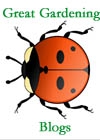The suggestions for which herbs you may choose to grow on your vegetable patch are now completed on the website click here
Herbs are a sort of half way house between flowers and vegetables. As well as having scented foliage, many have attractive flowers and variegated leaves. A herb garden can be ornamental as well as productive. Herbs can be mixed in amongst other ornamental or food plants; they can be grown in containers or in a patch devoted to growing herbs. Herbs are ideal plants for the sensory garden as not only can they contribute a mixture of flavours and scents but many have a particular texture.
Many herbs flowers are much loved by butterflies and bees so a herb patch can encourage biodiversity in your vegetable patch and encourage beneficial insects which in turn will pollinate fruit or help keep insect pests under control.
The word herb has various definitions, on this page the term herb is used to describe a plant grown for flavouring, scent or medicinal purpose.
Growing herbs in a school garden is especially appropriate as many plants date back to the beginnings of civilisation and can be linked to a study of a particular historical period. Herbs were used in the courts of ancient Egypt, Greece and Rome. Ancient Egyptians used herbs for medicinal purpose and also in the embalming process. Ancient peoples believed some herbs had magical properties and they were used to protect from evil and in rituals. Each herb had a special significance or power attributed to it. Herbs have even been used as currency.
Through the ages herbs continued to be used medicinally as some still are today. They were also used to flavour food especially when food became tainted during storage. Not only would use of herbs mask unpleasant tastes but was thought to act as a disinfectant on particularly bad meat. Herbs were burned as a fumigant. Bad smells were often associated with disease and herbs were used to mask odours. To fulfil this, aim herbs would be stuffed into keyholes and shoes or herb bags would be worn from a belt. They have also been used as ingredients in dyes and cosmetics.
In the 16 and 17 century herb gardens became popular in cottages, castles, and monasteries although wild herbs were considered to be more powerful than cultivated ones. Herb women and root gatherers made a living collecting herbs growing wild in the countryside. Some of these women were persecuted and tried as witches. Herbs were also grown by apothecaries in physic gardens.




















2 comments:
I cannot imagine our garden without herbs: lemon thyme, rosemary, basil, oregano, cilantro, bay..
I love coriander too (I think that is what you call cilantro) but I haven't found it particularly easy to grow
Post a Comment
Thank you for visiting my blog and leaving a comment - it is great to know that there are people out there actually reading what I write! Come back soon. It would be great to receive some photos of your school plot to post on my website as an inspiration to others!
(By the way any comments just to promote a commercial site, or any comments not directly linked to the theme of my blog, will be deleted)